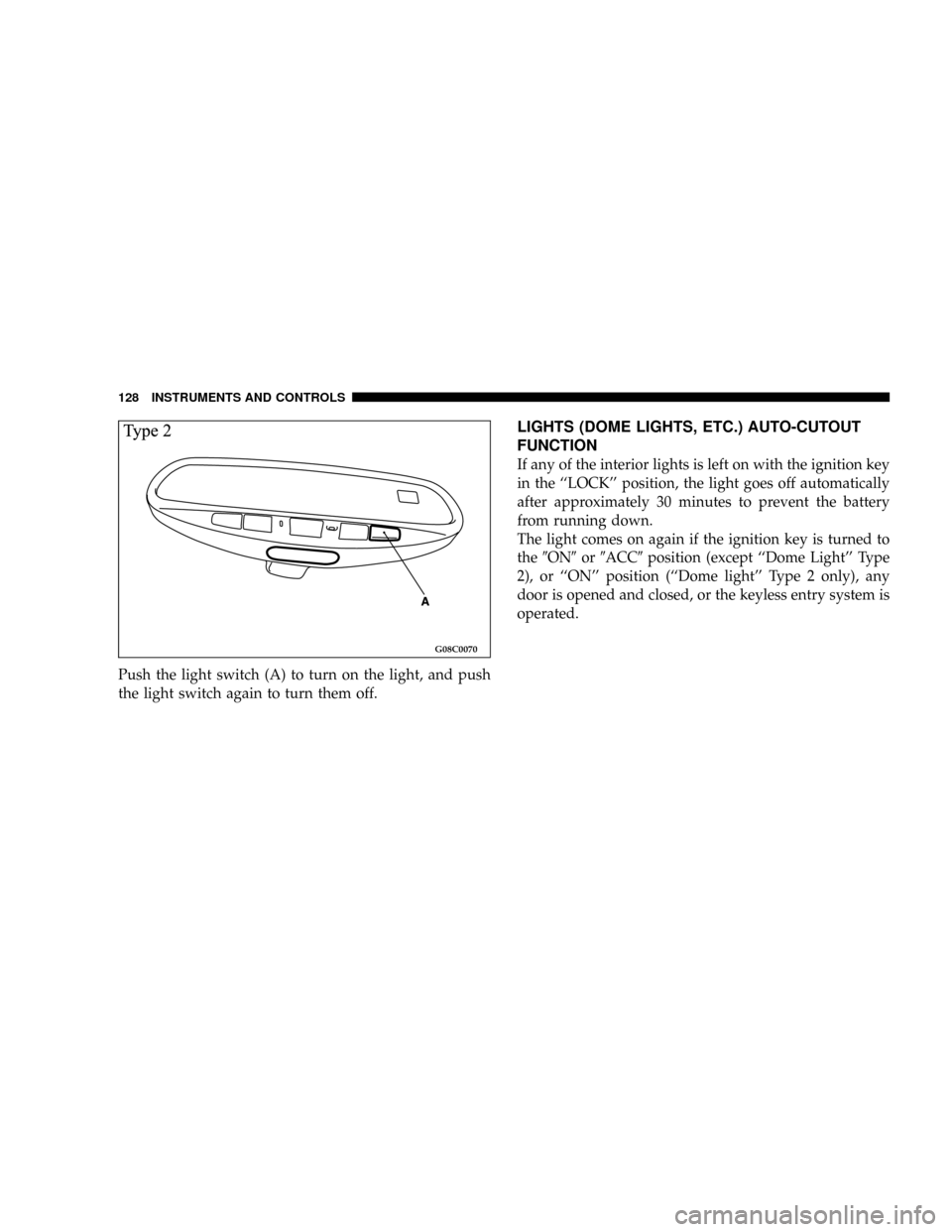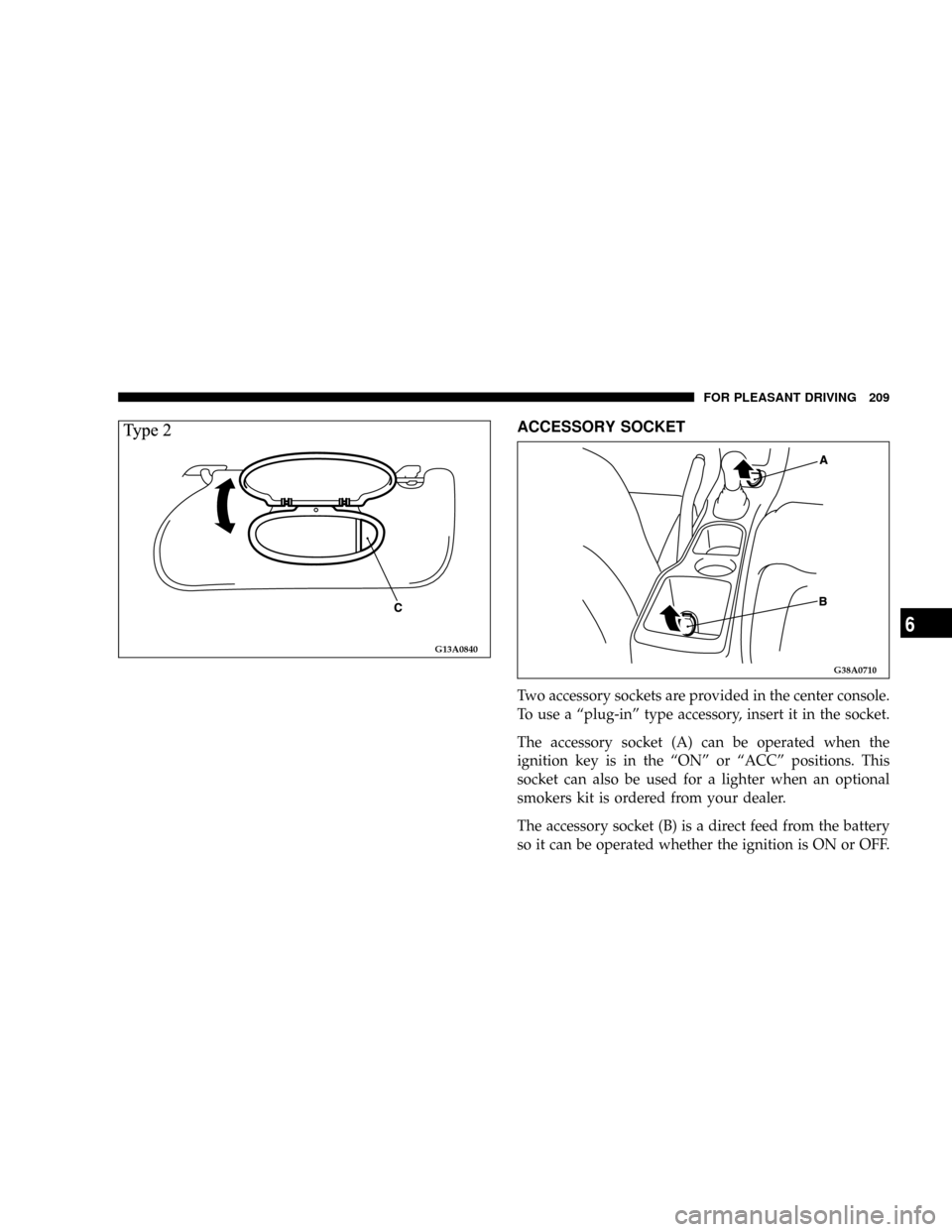key battery CHRYSLER SEBRING COUPE 2004 2.G User Guide
[x] Cancel search | Manufacturer: CHRYSLER, Model Year: 2004, Model line: SEBRING COUPE, Model: CHRYSLER SEBRING COUPE 2004 2.GPages: 382, PDF Size: 2.23 MB
Page 122 of 382

NOTE
1. If the headlights are switched to high beam, the fog
lights will go out; they will illuminate again when the
headlights are switched back to low beam.
2. If the light switch is rotated to OFF while the fog lights
are illuminated, they will automatically turn off. They
can be turned back on again by moving the light switch
back to ON and pressing the fog light switch again.
HAZARD WARNING FLASHER SWITCH
Press the flasher switch and the front and rear turn
signals will flash intermittently, as the hazard warning
lights. This is an emergency warning system and is not
intended for use when the vehicle is in motion.
If it is necessary to leave the vehicle, the flasher system
will continue to operate with the ignition key removed.
NOTE: If the lights are kept flashing for several hours,
the battery will be discharged (rundown), resulting in
hard engine starting or a no start condition.
E16A0520
122 INSTRUMENTS AND CONTROLS
Page 124 of 382

It will turn off automatically in about 17 minutes.
To turn off the defogger before 17 minutes has lapsed,
push the switch again.
CAUTION!
²The rear window defroster is not designed to melt
snow. Remove snow before use of the rear win-
dow defroster.
²Use the rear window defroster only after the
engine has started and is running.
Be sure to turn the defroster switch off immedi-
ately after the window is clear in order to prevent
excessive battery discharge.
²Do not place stickers, tape or other items that are
attached with adhesive over the grid wires on the
rear window.
²When cleaning the inside rear window from in-
side, use a soft cloth and wipe lightly over the
heating wires.
WINDSHIELD WIPERS
The windshield wipers can be operated when the wiper
lever is moved as illustrated above and the ignition key is
in the ªONº or ªACCº position.
MIST = Misting function
The wipers will operate once
OFF = Off
INT = Speed sensitive
Interval between wipers varies in accordance
with vehicle speed
E13A1500
124 INSTRUMENTS AND CONTROLS
Page 128 of 382

Push the light switch (A) to turn on the light, and push
the light switch again to turn them off.
LIGHTS (DOME LIGHTS, ETC.) AUTO-CUTOUT
FUNCTION
If any of the interior lights is left on with the ignition key
in the ``LOCK'' position, the light goes off automatically
after approximately 30 minutes to prevent the battery
from running down.
The light comes on again if the ignition key is turned to
the9ON9or9ACC9position (except ``Dome Light'' Type
2), or ``ON'' position (``Dome light'' Type 2 only), any
door is opened and closed, or the keyless entry system is
operated.
G08C0070
128 INSTRUMENTS AND CONTROLS
Page 148 of 382

NOTE: For vehicles with an automatic transaxle, the key
cannot be removed unless the selector lever is set to the
ªPº (PARK) position.
ACC
Allows operation of electrical accessories with the engine
off.
START
Engages the starter. After the engine starts, release the
key and it will return automatically to the ªONº position.
ON
The engine runs and all accessories can be used.
NOTE:Do not use the ªONº position to operate acces-
sories.
CAUTION!
²Do not remove the ignition key from the ignition
switch while driving. The steering wheel will
lock, causing loss of control.
²If the engine is turned off while driving, the
power brake servomechanism will cease to func-
tion and braking efficiency will deteriorate. Also,
the power steering system will not function and it
will require greater effort to operate the steering.
²Do not leave the key in the ªONº position for a
long time when the engine is not running; doing
so will cause the battery to discharge.
²Do not turn the key to the ªSTARTº position
when the engine is running; doing so could dam-
age the starter motor.
KEY REMINDER CHIME
If the driver's door is opened while the ignition key is in
the ªLOCKº or ªACCº position, a warning chime
sounds.
148 STARTING AND DRIVING
Page 149 of 382

THEFT PROTECTION
CAUTION!
Always remove the key from the ignition switch and
lock all doors when leaving the vehicle unattended.
Always try to park your vehicle in a well lighted
area.
The ignition key can only be removed in the ªLOCKº
position. If the key is left in the lock cylinder, a warning
chime sounds when the driver's door is opened.
NOTE: If your vehicle is equipped with a Theft-alarm
system, refer to ªTheft-alarm systemº.
STEERING LOCK
Withdraw the key and the steering wheel will be locked.
Turn the steering wheel to confirm that it is locked.
CAUTION!
If your vehicle needs to be towed, turn the key to the
(ACC(position to unlock the steering wheel.
STARTING
Tips for starting
1. Do not operate the starter motor continuously for
longer than 15 seconds at a time; doing so could run
down the battery. If the engine does not start, turn the
ignition switch back to ªLOCKº, wait a few seconds, and
then try again.
2. If the engine will not start because the battery is weak
or dead, refer to ªJump-starting the engineº section (page
273) for instructions on starting the engine.
3. The engine is well warmed up if the pointer of the
coolant temperature gauge starts to move. Extended
warm up operation will result in excessive fuel consump-
tion.
STARTING AND DRIVING 149
5
Page 152 of 382

CAUTION!
The electronically controlled transaxle system is
strictly intended to provide supplementary func-
tions. When driving downhill under certain condi-
tions, or immediately after starting when the auto-
matic transaxle is cold, no automatic shift-down may
be made. The driver should shift down to a low gear
(3rd gear or 2nd gear), which will permit the engine
to exert a braking effect.
NOTE: During the brake-in period or immediately after
re-connection of the battery cable, the vehicle may not
shift as smoothly. This does not indicate a faulty trans-
mission. The transaxle system must have a short period
to learn parameters for proper shifting. Shifting will
become smooth after the transaxle has been shifted
several times by the electronic control system.
Selector lever operation
As an additional safety precaution, models equipped
with an automatic transaxle have a shift-lock device that
holds the selector lever in the ªPº (PARK) position. To
move the selector lever from the ªPº (PARK) position to
another position, follow the steps below.
1. Depress and hold down the brake pedal.
2. Move the selector lever to the desired position.
NOTE: The selector lever cannot be moved from ªPº
(PARK) to another position if the ignition key is at the
ªLOCKº position, removed, or if the brake pedal is not
depressed and held down.
152 STARTING AND DRIVING
Page 209 of 382

ACCESSORY SOCKET
Two accessory sockets are provided in the center console.
To use a ªplug-inº type accessory, insert it in the socket.
The accessory socket (A) can be operated when the
ignition key is in the ªONº or ªACCº positions. This
socket can also be used for a lighter when an optional
smokers kit is ordered from your dealer.
The accessory socket (B) is a direct feed from the battery
so it can be operated whether the ignition is ON or OFF.
G13A0840
G38A0710
FOR PLEASANT DRIVING 209
6
Page 275 of 382

CAUTION!
Driving with a hot cooling system could damage
your vehicle. If temperature gauge reads ªHº, pull
over and stop the vehicle. Idle the vehicle with the
air conditioner turned off until the pointer drops
back into the normal range. If the pointer remains on
the ªHº, turn the engine off immediately, and call for
service.
WARNING!
A hot engine cooling system is dangerous. You or
others could be badly burned by steam or boiling
coolant. You may want to call a service center if your
vehicle overheats. If you decide to look under the
hood yourself, see Maintenance Section of this
manual. Follow the warnings under the Cooling
System Pressure Cap paragraph.
WARNING!
²When working near the radiator cooling fan, dis-
connect the fan motor lead or turn the ignition key
to the OFF position. The fan is temperature con-
trolled and can start at any time the ignition key is
in the ON position.
²You or others can be badly burned by hot coolant
or steam from your radiator. If you see or hear
steam coming from under the hood, don't open
the hood until the radiator has had time to cool.
Never try to open a cooling system pressure cap
when the radiator is hot.
JUMP-STARTING THE ENGINE
If the engine cannot be started because the battery is
weak or dead, the battery from another vehicle can be
used with booster cables to start the engine.
EMERGENCIES 275
8
Page 276 of 382

WARNING!
When using jumper cables to start a vehicle, follow
procedures exactly and exercise extreme caution.
CAUTION!
Do not try to start your vehicle by pushing or towing.
Vehicles equipped with an automatic transaxle can-
not be started this way. Pushing or towing a vehicle
equipped with a manual transaxle may overheat and
damage the catalytic converter. Also, there is a
greater risk of an accident when a vehicle is being
pushed or towed.
1. Remove any metal jewelry such as watch bands or
bracelets that might make an inadvertent electrical con-
tact.
2. Position the vehicles close enough together so the
booster cables can reach, but be sure the vehicles aren't
touching each other. If they are, it could cause a groundconnection. You wouldn't be able to start your vehicle,
and the bad ground could damage the electrical systems.
CAUTION!
Check the other vehicle. It must have a 12-volt
battery. If the other system isn't 12-volts, both sys-
tems can be damaged.
3. You could be injured if the vehicles move. Set the
parking brake firmly on each vehicle. Put an automatic
transaxle in ªPº (PARK) or a manual transaxle in ªNº
(Neutral). Turn the ignition key to the ªLOCKº position.
WARNING!
Turn the ignition key to the ªLOCKº position on
both vehicles.
Use care to make sure that the cables or your clothes
are never caught by the fan or drive belt. Personal
injury could result.
276 EMERGENCIES
Page 307 of 382

WARNING!
²The fan may turn on automatically even if the
engine is not running; turn the ignition key to the
ªLOCKº position and remove the key to ensure
safety while you work in the engine compartment.
²Do not smoke, or allow open flames around fuel
or the battery. The fumes are flammable.
²Be extremely cautious when working around the
battery. It contains poisonous and corrosive sulfu-
ric acid.
²Do not get under your vehicle with just the car's
jack supporting it.
Always use properly rated automotive jack
stands.
²Improper handling of components and materials
used in the vehicle can endanger your personal
safety. Consult an authorized dealer if you have
questions.
EMISSION-CONTROL SYSTEM MAINTENANCE
Your vehicle is equipped with an emission-control sys-
tem which satisfies all requirements of the U.S. Environ-
mental Protection Agency. The emission-control system
consists of:
(1) a positive crankcase ventilation system
(2) an evaporative emission-control system
(3) an exhaust emission- control system.
The9Scheduled9maintenance services listed must be
performed at the times or mileages specified to assure the
continued proper functioning of the emission-control
system. These, and all other ªGeneralº maintenance
services included in this manual, should be performed to
provide the best vehicle performance and reliability.
More frequent maintenance may be needed for vehicles
driven under severe operating conditions such as dusty
areas and frequent start and stop driving.
In order to assure the proper function of the emission-
control system, it is recommended that you have your
vehicle inspected and maintained by an authorized
dealer in accordance with the schedule in this manual.
Inspection and service should also be performed any
time a malfunction is suspected.
MAINTENANCE 307
9